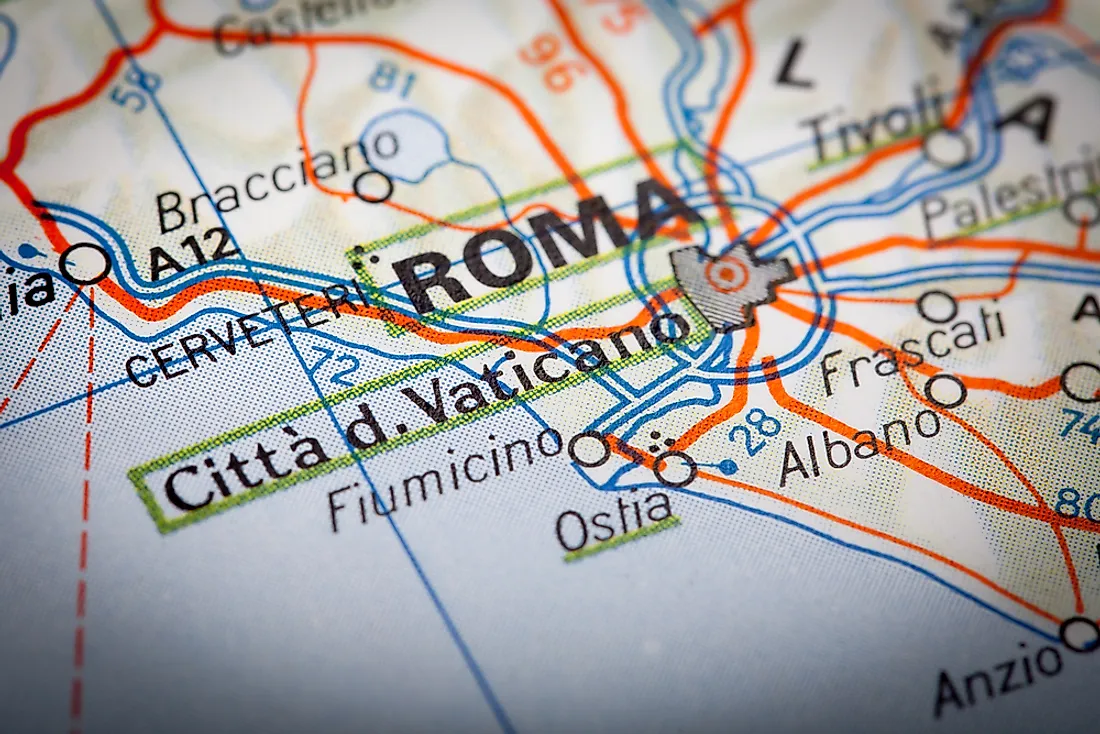Which Countries Border Vatican City?

Vatican City is significant for a number of reasons. It holds the title of the smallest country in the world both in relation to its land area as well as in relation to its minute and church-based population. With a land area of more than a hundred acres, Vatican City is surrounded by a two-mile border that it shares with the European country of Italy. This city-state within a city (Rome) is the permanent home of about a thousand people all of whom have a connection with the Catholic Church either as clergy, religious diplomats, members of the Swiss Guard, or various other lay people employed by the Catholic Church. Despite its political status as an independent city-state Vatican City is run as an absolute monarchy which is led by the head of the Roman Catholic Church, the Pope.
Politically independent and not bound by Italian rule, Vatican City operates as an enclave or territory surrounded on all sides by the country of Italy, and even more specifically by the city of Rome. Vatican City was founded in 1929 following the implementation of the Lateran Treaty, a bilateral agreement between the government of Italy and the Holy See. At the time of its signing, the Prime Minister of Italy was the notorious Fascist leader Benito Mussolini who was well known for having a tumultuous relationship with the church. Acting on behalf of King Victor Emmanuel III, Il Duce granted Vatican City the right to operate under the laws of the Roman Catholic Church rather than according to Italian law. The Lateran Treaty also formally established Catholicism as Italy’s national religion as well as awarded the Church $92 million for the Papal States.
Italy
Due to the fact that Vatican City is surrounded by Italy, it isn’t surprising that this southern European country has had a major influence on the world’s smallest sovereign state and vice versa. Italy’s system of government operates as a constitutional republic. The country is home to about 60,483,973 citizens most of whom identify as Roman Catholics. Almost 75% of those who regularly attend religious services in the nation belong to the Catholic Church. Even in 2018 Italy continues to operate under the strongly entrenched influence of the Roman Catholic Church even despite the fact that the country no longer has an official religion. Other minority faiths found in Italy include various Protestant denominations such as Methodists, Lutherans, Seventh-day Adventists, Pentecostals, Baptists, and Jehovah's Witnesses as well as members of the Jewish faith, and Indian based belief systems such as Sikhism.
Italy has a long and illustrious history including serving as the homeland for a variety of ancient societies including the Latins, Samnites, Celts, and Umbrians. The country was also the birthplace of the Roman Empire which lasted from approximately 27 BC till 395 AD and saw the rise of the Emperors, widespread colonization, a focus on military exploration and maintaining a strong and fearsome battle-ready military force, as well as a countless array great cultural and artistic advancements.
After suffering tremendous losses both in terms of human sacrifice and property damage during both World War I and World War II, Italy officially became a republic in 1946. In the modern era, Italy boasts the world's eighth-largest economy. The country is well known for its history, architecture, cuisine, music, literature, film as well as its high-end fashion industry and manufacturer of expensive luxury automobile brands as Ferrari, Maserati, and Lamborghini.
Rome
Because Vatican City operates within the Italian capital city of Rome it is important to recognize how these two independent political jurisdictions have been able to successfully co-exist over the years. The Holy See (otherwise known as the See of Rome) has a complex relationship with the urban city of Rome. Vatican City is considered to be a sovereign state which is under the jurisdiction of the Holy See. Indeed, the Bishop of Rome is the Pope who is also head of the Catholic Church as well as the top official of Vatican City. It should come as no surprise that in our modern age, the religious beliefs of the Church can often be in direct conflict with modern politics and issues relating to personal rights and freedoms. Despite being its own sovereign state, Vatican City and its top officials still hold a great deal of influence and political sway over Italy’s political landscape. One example which highlights the unique and complicated connection shared between the Vatican and Italy is the fact that religious courses in Italian schools are reflective of the belief system preached by the Roman Catholic Church. Due to the strong influence exercised by the Pope and the Catholic Church, there are no right to life laws in Italy.
Despite disagreements as to whether or not the Vatican should be subjected to Italian taxes, it is important to remember that the prestigious religious institution also plays a prominent role in the economy of both Rome and the nation of Italy. Vatican City became a UNESCO Heritage Site in 1984 and routinely attracts millions of tourists and worshippers alike to Rome and its surrounding areas. Rome receives a great deal of monetary benefits from having Vatican City as a part of the city. This revenue comes as a result of visitors staying in local hotels, eating in local restaurants, and purchasing a wide array of locally made products.
One of Vatican City’s most popular sites is St. Peter’s Basilica, a one of a kind Italian Renaissance church which is renown as the largest such church in the world. Construction began in 1506 and it was designed by such masters as Gian Lorenzo Bernini, Michelangelo, Donato Bramante, and Carlo Maderno. Known as one of the holiest of Catholic shrines, St. Peter’s is thought to house the buried remains of St. Peter who was one of Jesus’ apostles and the first man to hold the title of bishop of Rome.











